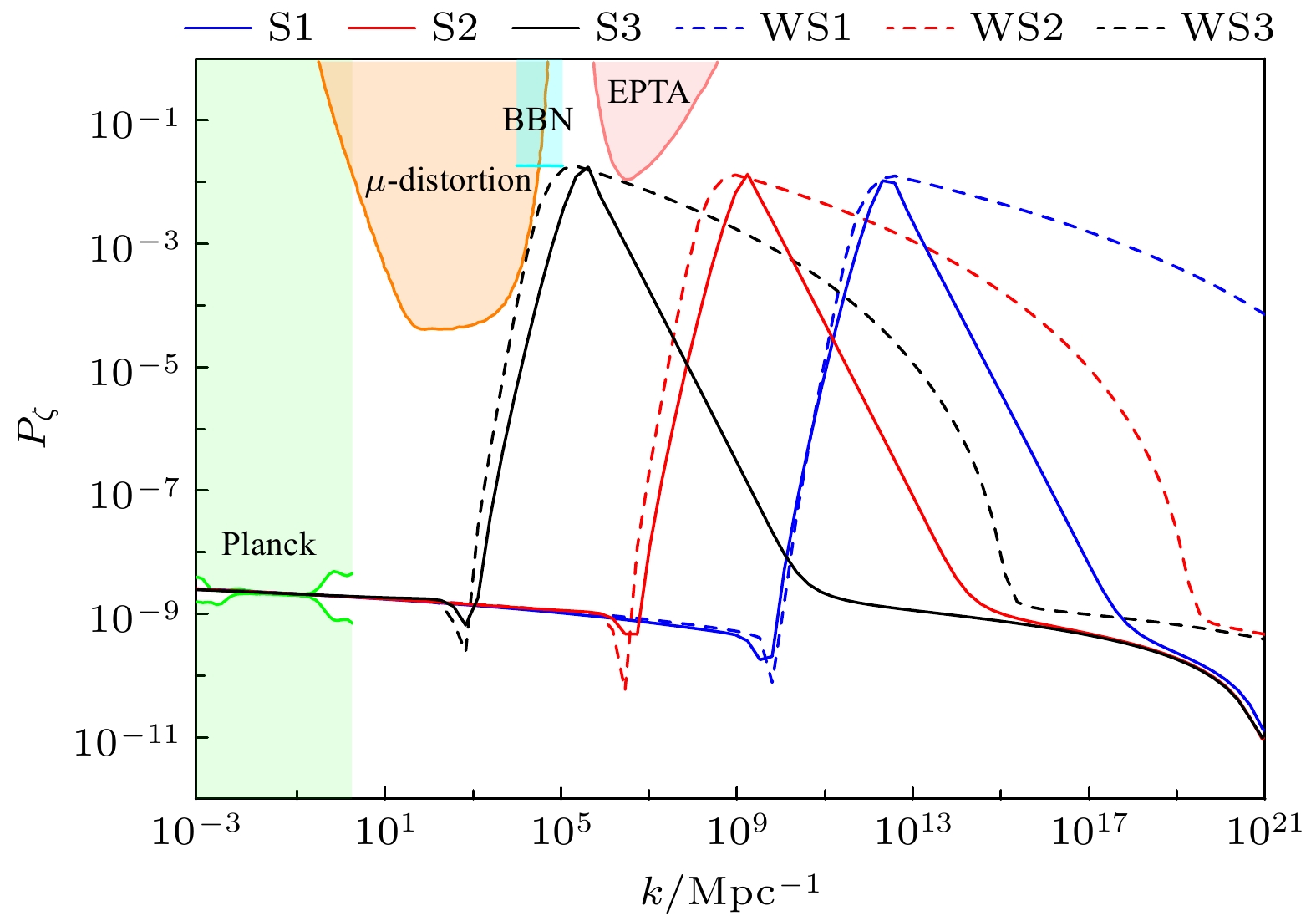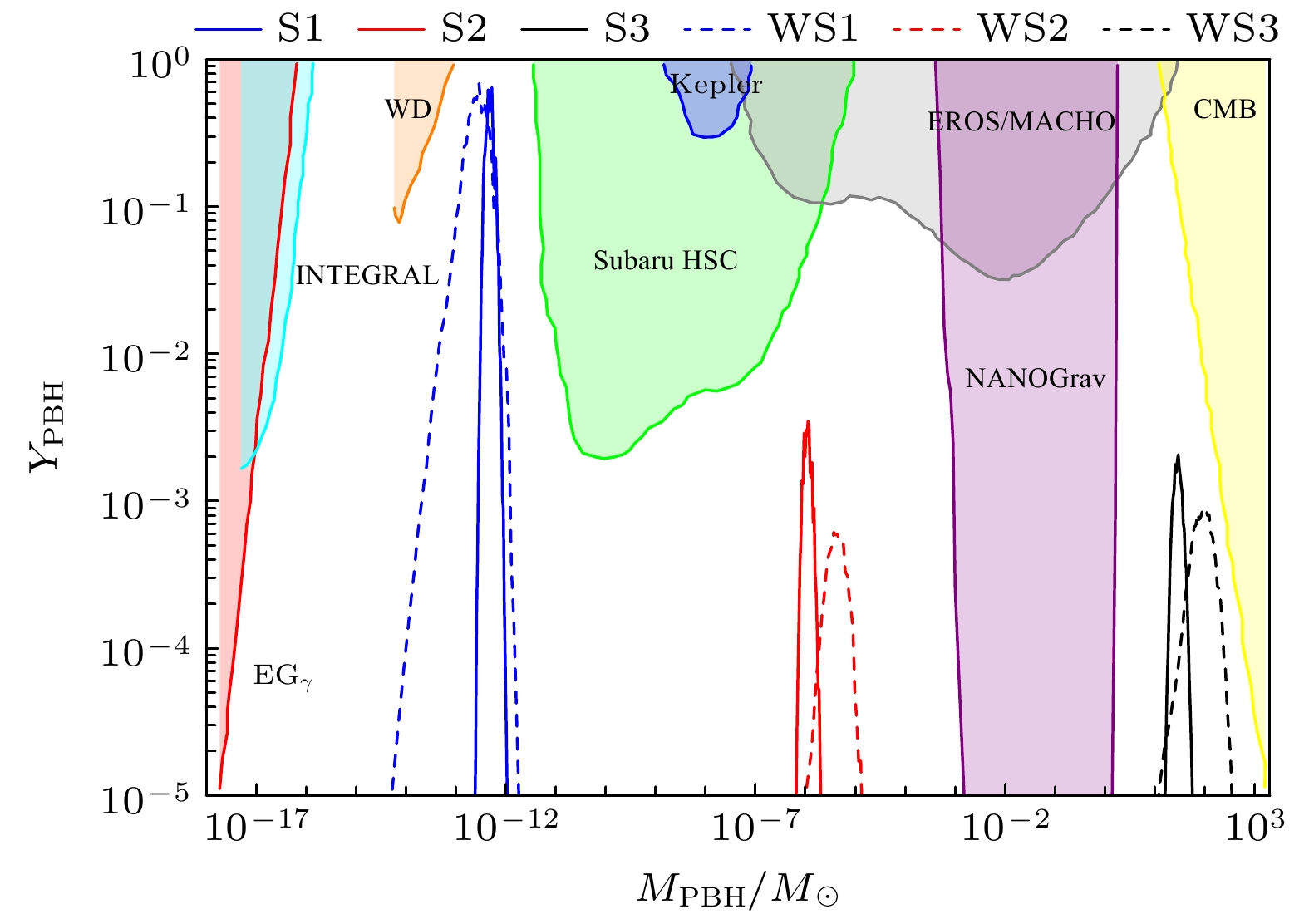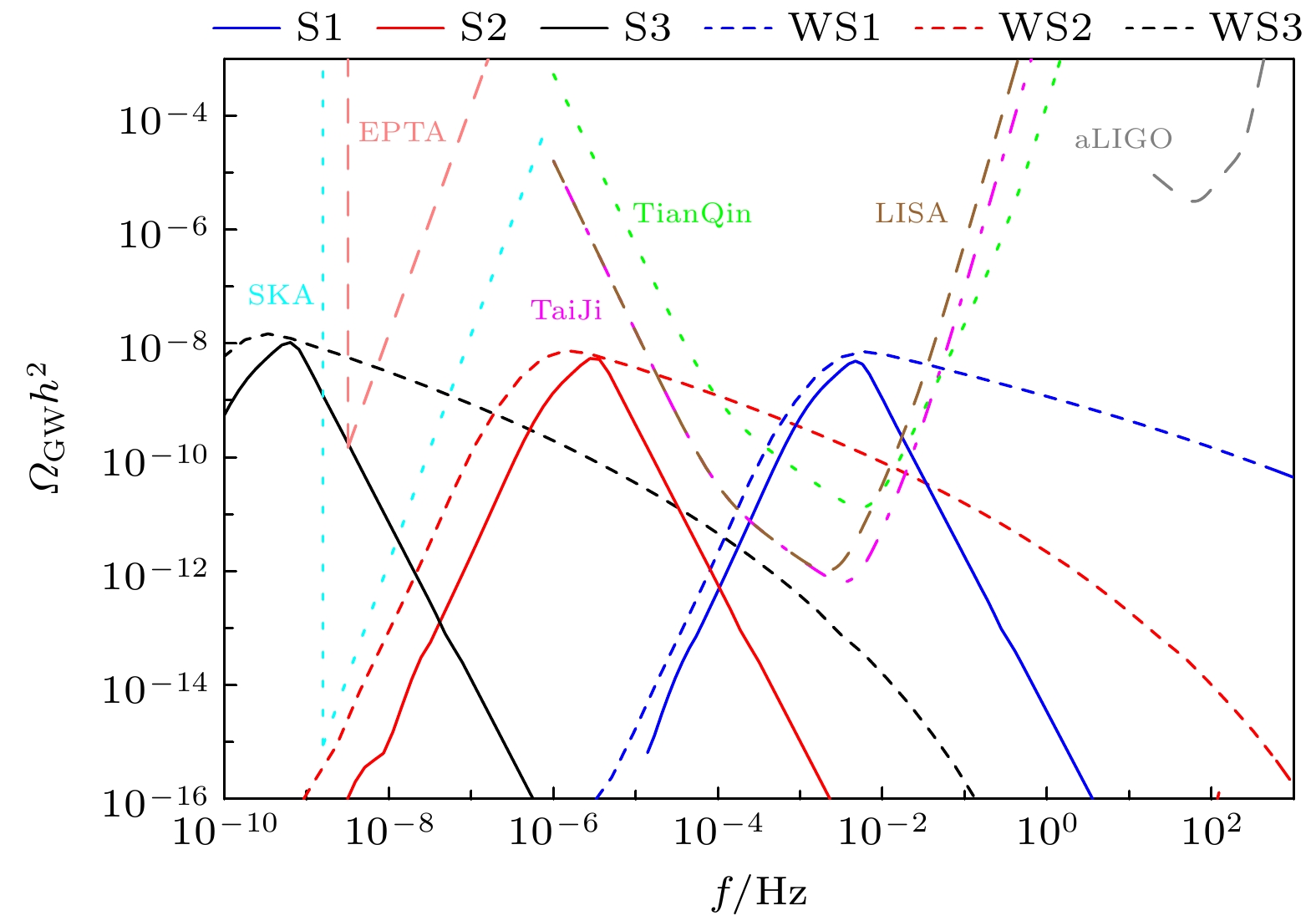-
It is discussed in this work to produce primordial black hole (PBH) dark matter (DM) and scalar induced secondary gravitational waves by using the enhancement mechanism with a peak function in the non-canonical kinetic term in S-dual inflation. It is shown explicitly that the power spectrum for the primordial curvature perturbation can be enhanced at 1012, 108 and 105 Mpc–1, respectively, that the primordial black hole dark matter with peak mass around 10–13 solar mass, the Earth’s mass and the stellar mass are generated, respectively, and that the scalar induced gravitational wave with peak frequency around mHz, μHz and nHz are created, respectively. The primordial black hole with the mass scale 10–13 solar mass can make up almost all the dark matter and the associated scalar induced secondary gravitational waves is testable by spaced based gravitational wave observatory. The amplitude of primordial curvature perturbations on a small scale can become large by the enhancement mechanism with a peak function in the non-canonical kinetic term. We apply the enhancement mechanism to S-dual inflation to produce abundant PBHs and observable scalar induced gravitational waves (SIGWs). The power spectrum on a large scale is consistent with observational constraint, and the power spectrum on a small scale is enhanced to the 0.01. It is possible that either sharp peak or broad peak possesses a different peak shape for the peak function by choosing a different value of q. By adjusting the peak position ϕp in the peak function, the power spectrum is enhanced on a different scale, henceforth associated with the generation of SIGWs with a different peak frequency, PBHs with different mass are produced. We choose three different values of ϕp to obtain enhance power spectrum at 1012, 108 and 105 Mpc–1, respectively. The enhanced curvature perturbation produces PBH DM with peak mass around 10–13 solar mass, the Earth’s mass and the stellar mass, and SIGW with peak frequency around mHz, µHz and nHz, respectively. The stellar mass PBHs may explain black holes observed by LIGO/Virgo collaboration, and the earth-mass PBHs may explain the planet 9. The PBH with the mass scale 10–13 solar mass can make up almost all the dark matter. The SIGW with the peak frequency around nHz is testable by pulsar timing array observations, and SIGW with the peak frequency around mHz is testable by space based GW observatory. The results show that the enhancement mechanism with a peak function in the non-canonical kinetic term works for S-dual inflation. [1] Abbott B P, Abbott R, Abbott T D, et al. 2016 Phys. Rev. Lett. 116 061102
 Google Scholar
Google Scholar
[2] Hawking S 1971 Mon. Not. Roy. Astron. Soc. 152 75
 Google Scholar
Google Scholar
[3] 郜青, 龚云贵, 龙江 2021 中山大学学报(自然科学版) 60 86
 Google Scholar
Google Scholar
Gao Q, Gong Y G, Long J 2021 Acta Scientiarum Naturalium Universitatis Sunyatseni 60 86
 Google Scholar
Google Scholar
[4] Carr B, Kuhnel F 2020 Annu. Rev. Nucl. Part. Sci. 70 355
 Google Scholar
Google Scholar
[5] Scholtz J, Unwin J 2020 Phys. Rev. Lett. 125 051103
 Google Scholar
Google Scholar
[6] Inomata K, Nakama T 2019 Phys. Rev. D 99 043511
 Google Scholar
Google Scholar
[7] Danzmann K 1997 Class. Quantum Grav. 14 1399
 Google Scholar
Google Scholar
[8] Hu W R, Wu Y L 2017 Natl. Sci. Rev. 4 685
 Google Scholar
Google Scholar
[9] 罗俊, 艾凌皓, 艾艳丽等 2021 中山大学学报(自然科学版) 60 1
 Google Scholar
Google Scholar
Luo J, Ai L H, Ai Y L, et al. 2021 Acta Scientiarum Naturalium Universitatis Sunyatseni 60 1
 Google Scholar
Google Scholar
[10] Lu Y Z, Gong Y G, Yi Z, et al. 2019 J. Cosmol. Astropart. Phys. 12 1
 Google Scholar
Google Scholar
[11] Akrami Y, Arroja F, Ashdown M, et al. 2020 Astron. Astrophys. 641 A10
[12] Anchordoqui L A, Barger V, Goldberg H, et al. 2014 Phys. Lett. B 734 134
 Google Scholar
Google Scholar
[13] Inomata K, Kawasaki M, Tada Y 2016 Phys. Rev. D 94 043527
 Google Scholar
Google Scholar
[14] Fixsen D J, Cheng E S, Gales J M, et al. 1996 Astrophys. J. 473 576
 Google Scholar
Google Scholar
[15] Carr B J, Kohri K, Sendouda Y, et al. 2010 Phys. Rev. D 81 104019
 Google Scholar
Google Scholar
[16] Dasgupta B, Laha R, Ray A 2020 Phys. Rev. Lett. 125 101101
 Google Scholar
Google Scholar
[17] Graham P W, Rajendran S, Varela J 2015 Phys. Rev. D 92 063007
 Google Scholar
Google Scholar
[18] Niikura H, Takada M, Yasuda N, et al. 2019 Nature Astron. 3 524
 Google Scholar
Google Scholar
[19] Griest K, Cieplak M, Lehner M J 2013 Phys. Rev. Lett. 111 181302
 Google Scholar
Google Scholar
[20] Tisserand P, Guillou L L, Afonso C, et al. 2007 Astron. Astrophys. 469 387
 Google Scholar
Google Scholar
[21] Chen Z C, Chen Y, Huang Q G 2020 Phys. Rev. Lett. 124 251101
 Google Scholar
Google Scholar
[22] Moore C, Cole R, Berry C 2015 Class. Quantum Grav. 32 015014
 Google Scholar
Google Scholar
[23] Aasi J, Abbott B P 2015 Class. Quantum Grav. 32 074001
 Google Scholar
Google Scholar
-
图 1 不同模型的功率谱. 实线代表q = 1的模型, 虚线代表q = 5/4的模型. 蓝色、红色和黑色分别代表峰值为1012, 108和105 Mpc–1的模型. 模型的参数和峰值见表1, 峰值对应的功率谱数值见表2. 浅绿色区域是被CMB观测结果排除的参数范围[11], 粉色、天蓝色和橘色区域分别代表EPTA[6], BBN[13], μ-distortion[14]排除的参数范围
Figure 1. Power spectra of the different models. Implement the model representing q = 1, the dashed line represents the model of q = 5/4. Blue, red and black respectively represent the model with a peak value of 1012, 108 and 105 Mpc–1. Parameters and peak values of the model are in Table 1, and the power spectrum values corresponding to the peak value are in Table 2. The light green area is the parameter range excluded by the CMB observation results[11], and the pink, sky blue and orange areas represent the parameter range excluded by EPTA[6], BBN[13] and μ-distortion[14] respectively.
图 2 不同模型的原初黑洞丰度. 模型参数同表1, 峰值对应的丰度和质量见表2. 阴影区域表示不同观测结果的排除区域, 黄色区域是微波背景辐射的限制结果[11] (CMB); 红色区域是利用银河系外
$\gamma $ 射线观测原初黑洞蒸发的限制结果[15] (${{{\rm{EG}}} _\gamma }$ ); 天蓝色区域是银河系中心511 keV$\gamma $ 射线的限制结果[16] (INTEGRAL); 橘色区域是白矮星爆发的限制结果[17] (WD); 绿色区域是源自Subaru HSC引力透镜事件的限制结果[18] (Subaru HSC); 蓝色区域是开普勒卫星的限制结果[19] (Kepler); 灰色区域是EROS/MACHO的限制结果[20] (EROS/MACHO); 紫色区域是2011年NANOGrav数据的限制结果[21] (NANOGrav)Figure 2. Primary black hole abundance of different models. Model parameters are the same as Table 1, and the abundance and quality corresponding to the peak are listed in Table 2. Shaded areas represent exclusion areas for different observations: the yellow area is the result of the restriction of microwave background radiation[11] (CMB); the red area is the result of the restriction of the primary black hole evaporation observed by the extragalactic ray[15] (
${\rm{EG} _\gamma }$ ); the sky blue region is the result of 511 keV ray limitation at the center of the galaxy[16] (INTEGRAL); the orange area is the result of the limit of the white dwarf star explosion[17] (WD); the green area is the limiting result of the gravitational lens event from Subaru HSC[18] (Subaru HSC); the blue area is the limited result of Kepler satellite[19] (Kepler); the grey area is the result of the limitation of EROS/MACHO[20] (EROS/MACHO); the purple area is the result of the limitation of NANOGrav 2011-year data[21] (NANOGrav).图 3 次级引力波的能量密度. 模型参数同表1, 峰值对应的丰度和质量在表2列出. 橘色虚线表示EPTA的限制结果[6]; 天蓝色虚线表示SKA的限制结果[22]; 绿色虚线表示天琴的限制结果[9]; 紫色虚线表示太极的限制结果[8]; 棕色虚线表示LISA的限制结果[7]; 灰色虚线表示aLIGO的限制结果[23]
Figure 3. Energy density of secondary gravitational waves, the model parameters are the same as Table 1, and the abundance and quality corresponding to the peak are listed in Table 2. The orange dotted line represents the limit result of EPTA[6]; the sky blue dotted line represents the limit result of SKA[22]; the green dotted line represents the limit result of Tianqin[9]; the purple dotted line represents the limit result of Taiji[8]; the brown dotted line represents the limit result of LISA[7]; the gray dotted line represents the limit result of aLIGO[23].
表 1 模型参数及数值计算结果
Table 1. Model parameters and the numerical calculation results.
模型 h/1011 w/10–11 ${\phi _{\text{p}}}$ ${\phi _ * }$ N ${n_{\text{s}}}$ r kpeak/(105 Mpc–1) S1 5.90 1.0 2.118 2.325 51.85 0.961 0.045 2.65×107 S2 5.82 1.0 2.104 2.313 51.25 0.963 0.045 1.81×104 S3 5.83 1.0 2.095 2.308 51.16 0.968 0.043 3.55 WS1 183 1.0 2.122 2.24 66.59 0.965 0.040 3.57×107 WS2 140 1.0 2.104 2.24 60.13 0.965 0.040 9.99×103 WS3 123 1.0 2.095 2.24 58.89 0.965 0.040 1.88 表 2 模型的峰值功率谱、原初黑洞质量、丰度和峰值频率的数值
Table 2. Peak power spectrum of the model, the mass, abundance and peak frequency of the primary black hole.
模型 ${P_{\varsigma ({\rm{peak}})}}$ ${M_{{{\rm{peak}}} }}/{M_ \odot }$ $Y_{{\rm{PBH}}}^{{\rm{peak}}}$ ${f_{\text{c}}}/{{\rm{Hz}}} $ S1 0.0128 5.23×10–13 0.647 4.81×10–3 S2 0.0137 1.13×10–6 3.51×10–3 3.02×10–6 S3 0.0186 29.2 2.07×10–3 6.22×10–10 WS1 0.0127 2.88×10–13 0.687 4.95×10–3 WS2 0.0132 3.69×10–6 6.15×10–4 1.35×10–6 WS3 0.0185 104.3 9.01×10–4 2.96×10–10 -
[1] Abbott B P, Abbott R, Abbott T D, et al. 2016 Phys. Rev. Lett. 116 061102
 Google Scholar
Google Scholar
[2] Hawking S 1971 Mon. Not. Roy. Astron. Soc. 152 75
 Google Scholar
Google Scholar
[3] 郜青, 龚云贵, 龙江 2021 中山大学学报(自然科学版) 60 86
 Google Scholar
Google Scholar
Gao Q, Gong Y G, Long J 2021 Acta Scientiarum Naturalium Universitatis Sunyatseni 60 86
 Google Scholar
Google Scholar
[4] Carr B, Kuhnel F 2020 Annu. Rev. Nucl. Part. Sci. 70 355
 Google Scholar
Google Scholar
[5] Scholtz J, Unwin J 2020 Phys. Rev. Lett. 125 051103
 Google Scholar
Google Scholar
[6] Inomata K, Nakama T 2019 Phys. Rev. D 99 043511
 Google Scholar
Google Scholar
[7] Danzmann K 1997 Class. Quantum Grav. 14 1399
 Google Scholar
Google Scholar
[8] Hu W R, Wu Y L 2017 Natl. Sci. Rev. 4 685
 Google Scholar
Google Scholar
[9] 罗俊, 艾凌皓, 艾艳丽等 2021 中山大学学报(自然科学版) 60 1
 Google Scholar
Google Scholar
Luo J, Ai L H, Ai Y L, et al. 2021 Acta Scientiarum Naturalium Universitatis Sunyatseni 60 1
 Google Scholar
Google Scholar
[10] Lu Y Z, Gong Y G, Yi Z, et al. 2019 J. Cosmol. Astropart. Phys. 12 1
 Google Scholar
Google Scholar
[11] Akrami Y, Arroja F, Ashdown M, et al. 2020 Astron. Astrophys. 641 A10
[12] Anchordoqui L A, Barger V, Goldberg H, et al. 2014 Phys. Lett. B 734 134
 Google Scholar
Google Scholar
[13] Inomata K, Kawasaki M, Tada Y 2016 Phys. Rev. D 94 043527
 Google Scholar
Google Scholar
[14] Fixsen D J, Cheng E S, Gales J M, et al. 1996 Astrophys. J. 473 576
 Google Scholar
Google Scholar
[15] Carr B J, Kohri K, Sendouda Y, et al. 2010 Phys. Rev. D 81 104019
 Google Scholar
Google Scholar
[16] Dasgupta B, Laha R, Ray A 2020 Phys. Rev. Lett. 125 101101
 Google Scholar
Google Scholar
[17] Graham P W, Rajendran S, Varela J 2015 Phys. Rev. D 92 063007
 Google Scholar
Google Scholar
[18] Niikura H, Takada M, Yasuda N, et al. 2019 Nature Astron. 3 524
 Google Scholar
Google Scholar
[19] Griest K, Cieplak M, Lehner M J 2013 Phys. Rev. Lett. 111 181302
 Google Scholar
Google Scholar
[20] Tisserand P, Guillou L L, Afonso C, et al. 2007 Astron. Astrophys. 469 387
 Google Scholar
Google Scholar
[21] Chen Z C, Chen Y, Huang Q G 2020 Phys. Rev. Lett. 124 251101
 Google Scholar
Google Scholar
[22] Moore C, Cole R, Berry C 2015 Class. Quantum Grav. 32 015014
 Google Scholar
Google Scholar
[23] Aasi J, Abbott B P 2015 Class. Quantum Grav. 32 074001
 Google Scholar
Google Scholar
Catalog
Metrics
- Abstract views: 2114
- PDF Downloads: 50
- Cited By: 0















 DownLoad:
DownLoad:






